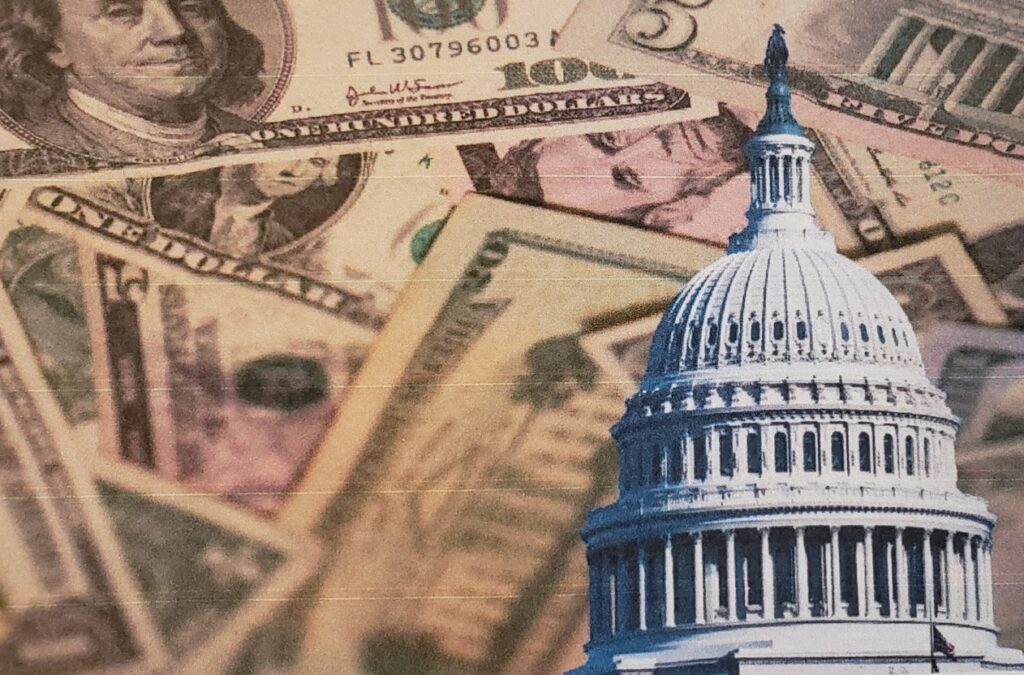
After the downgrade of America’s debt by Fitch Ratings, a drumbeat of negative assessments has followed in respect of how deep in the hole our country has plunged. That’s a good thing, since net interest on the debt is escalating rapidly on a track to hit an unsustainable and crippling $1 trillion in fiscal 2025.
Related Content: Debt, Not Debt Limit, Is the Crisis – Wall Street Journal
This fiscal year net interest is headed toward $700 billion, having already hit $561 billion in ten months, with $67 billion paid in July. Interest rates are at the highest levels in decades and likely to stay there, with the Federal Reserve saying it will hold rates “higher for longer.” Rates may climb further, as they have in recent days.
Most economic forecasters now see uninterrupted economic growth rather than a near-term recession that might bring rates down. Monetary experts are considering whether current rates are a new normal and whether the neutral rate of interest and the real rate of return may be higher than previously thought.
All this implies steady or rising interest rates and increases the likelihood that net interest will hit the projected $1 trillion. Numbers trending into the trillions tend to become surreal.
Related Content: Silent Price of Mounting U.S. Debt – Wall Street Journal

So, running the numbers on the increase on a step-by-step basis can bring home the reality of the skyrocketing interest cost — starting with the ongoing cost of the existing and staggering $25.8 trillion of publicly held debt that now saddles our economy.
According to the Treasury Department, the embedded interest rate on the debt at the end of July was 2.9 percent, which yields annual interest expense of $748 billion in fiscal 2024 and fiscal 2025. The next step is to calculate the increase in interest costs as existing below-market fixed-rate long-term debt matures and rolls over at prevailing rates.
In fiscal 2024, $2.7 trillion of long-term fixed-rate Treasuries will mature and roll over at current rates. Their weighted average original maturity is 4.5 years and their weighted average coupon interest rate is 1.5 percent. Rolled over at today’s 4.45 percent rate on 5-year Treasuries, they will produce additional interest at an annual rate of $86 billion and actual interest cost of an additional $43 billion in 2024.
The third step is to calculate the cost of new debt required to fund fiscal 2024 and 2025 deficits at an assumed $2 trillion, the same deficit as expected this fiscal year. According to the Congressional Budget Office, the deficit in the first ten months of this year, as adjusted by CBO, has surpassed $1.7 trillion, implying $2 trillion for the year.
Let’s assume that the $2 trillion of new debt is issued within the same term structure of the publicly held debt at the end of July and at roughly current market rates: 20 percent of the new debt raised by sales of T-Bills at 5.5 percent; 55 percent by the sale of Notes at 4.6 percent; and 15 percent by sales of Bonds at 4.4 percent. Finally, let’s assume 10 percent is raised in various other forms at a conservative assumed rate of 4 percent. That translates into a composite interest rate of 4.7 percent, producing additional interest at an annual rate of $94 billion and actual interest cost of $47 billion in fiscal 2024.
The three-step calculation implies $838 billion of actual net interest expense in fiscal 2024 and an annual running rate of $928 billion at the beginning of fiscal 2025. We don’t need calculations for fiscal 2025 on rollover debt nor the new debt for that year’s deficit to know that net interest will exceed $1 trillion in fiscal 2025, if the current outlook extends into 2025.
That would make interest the second-largest item in the federal budget after Social Security. That $1 trillion represents a tripling in four years and an amount equivalent to 15 percent of the current fiscal 2023 budget. Such escalation is patently unsustainable. Plus, the $300 billion increase in net interest over 2023 implies the axing of $300 billion of this year’s $1.7 trillion of discretionary spending. That shrinks discretionary spending to about 20 percent of the budget, leaving Congress exercising its constitutional power of the purse over only one-fifth of the budget.
What, though, if rates fall? What if the Fed cuts rates? That would happen if there were a serious recession. Yet in recession, tax revenue would fall, requiring greater borrowing. Additional interest on the greater amount of debt would offset the decline in interest cost occasioned by lower rates.
Maybe the stock market’s recent swoon signifies spreading realization of this dire outlook. It is difficult, in any event, to conjure an outlook under which debt and interest costs do not continue to escalate to catastrophic levels within just a few years — except under one scenario.
That would be a scenario in which Washington cuts its deficit spending. Now. Not next year or the year after. Sparing nothing. No, not even entitlements. Is that even imaginable with a U.S. Senate led by free-spending Democrats and with a White House occupied by a Democrat spender-in-chief?
![]()
Red Jahncke is a nationally recognized columnist, who writes about politics and policy. His columns appear in numerous national publications, such as The Wall Street Journal, Bloomberg, USA Today, The Hill, Issues & Insights and National Review as well as many Connecticut newspapers.





